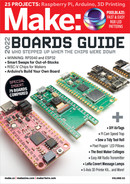
start (or end) of the next pulse. In other words,
the period is the duration of the pulse plus the
duration of the gap between it and the next
pulse. In the example shown here, the period is
measured in milliseconds.
When the signal from the 7555 passes through
the speaker, the cone of the speaker (also known
as its diaphragm) vibrates and converts each
pulse into a pressure wave in the air. When a
membrane in your ear responds to these pulses,
it enables your brain to experience them as
sound.
The frequency of a signal is the number of
pulses per second. This is expressed in hertz,
named after the electrical pioneer Gustav Ludwig
Hertz, and is abbreviated Hz (the H is capitalized,
because it refers to his name). A frequency of
100 pulses per second is written as 100Hz, while
1,000 pulses per second would be 1 kilohertz,
written as 1kHz, and 1,000,000 pulses per second
are 1 megahertz, written as 1MHz. The capital M
means mega. A lowercase m would mean milli, so
you must avoid getting them mixed up.
Human hearing can resolve sounds ranging
from around 20Hz to a maximum of 20kHz,
although elderly people may have difficulty
hearing sounds higher than 10kHz, and people
who have damaged their hearing as a result of
environmental noise (or rock concerts) may have
a limit as low as 5kHz.
A soundwave, consisting of alternating regions
with high pressure and low pressure, travels
through the air at approximately 1,125 feet per
second, at sea level. (At higher altitudes, sound
travels more slowly.) The distance from the start
of a high-pressure region to the start of the next
high-pressure region is called the wavelength.
If f is the frequency of a sound, measured in
Hz, and p is the period in seconds, and w is the
wavelength in feet, and s is the speed in feet per
second, these values are related by two simple
formulas, where the asterisk is a multiplication
sign:
f = 1 / p
s = w * f
You can see from the scale at the bottom of Figure
D that the period of this soundwave is about 3.5
milliseconds, or 0.0035 seconds.
Using the first formula, 1 / 0.0035 = 286Hz
(approximately). That’s the frequency of this
sound.
If you rewrite the second formula as
w = s / f, you can see that the wavelength of the
sound is 1,125 / 286 = about 4 feet.
THE CARRIER WAVE
In theory, you could disconnect the speaker from
your circuit and substitute a piece of wire, which
would function as a transmitting antenna. This
would radiate a small amount of power, which you
would be able to pick up by using another circuit
functioning as a receiver.
In practice, higher frequencies are better able
to transmit more power over longer distances.
In any case, if all radio stations in the world
transmitted audio frequencies, we would have no
way to separate them and listen to just one.
The answer to both problems is to add the
audio frequency to a much higher frequency,
known as a carrier wave, and assign a different
frequency of carrier wave to each radio station
in its area. If you look at the AM tuning dial on a
radio, you’ll see numbers ranging from 540kHz to
1,600kHz, which are carrier frequencies.
To add your audio soundwave to a carrier wave,
all you have to do in this experiment is connect a
second 7555 timer to the circuit that you just built.
A 7555 can run at up to 2MHz (which is the same
as 2,000kHz), so it is quite capable of transmitting
a signal in the AM waveband, even though it is
never normally used for that purpose.
First remove the speaker from the circuit that
you just built. You can also remove resistor R3
Charles Platt
10
8
6
4
2
0
-2
-4
-6
-8
-10
0 1 2 3 4 5 6 7 8 9 10
milliseconds
volts
D
A square-wave output from a 7555 timer running
in a stable mode.
65
make.co
M83_062-69_BookEx-Radio_F1.indd 65M83_062-69_BookEx-Radio_F1.indd 65 10/10/22 3:32 PM10/10/22 3:32 PM
..................Content has been hidden....................
You can't read the all page of ebook, please click here login for view all page.
